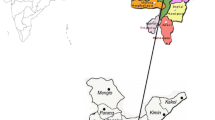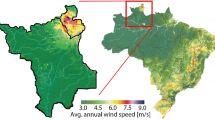Abstract
Understanding the inherent features of wind speed (variability on different time scales) has become critical for assured wind power availability, grid stability, and effective power management. The study utilizes the wavelet, autocorrelation, and FFT (fast Fourier transform) techniques to analyze and assimilate the fluctuating nature of wind speed data collected over a period of 29–42 years at different locations in the Kingdom of Saudi Arabia. The analyses extracted the intrinsic features of wind speed, including the long-term mean wind speed and fluctuations at different time scales (periods), which is critical for meteorological purposes including wind power resource assessment and weather forecasting. The long-term mean wind speed varied between 1.45 m/s at Mecca station and 3.73 m/s at Taif. The annual variation is the largest (±0.97 m/s) at Taif and the smallest (±0.25 m/s) at Mecca. Similarly, the wind speed fluctuation with different periods was also discussed in detail. The spectral characteristics obtained using FFT reveal that Al-Baha, Najran, Taif and Wadi-Al-Dawasser having a sharp peak at a frequency f = 0.00269 (1/day) retain a more regular annual repetition of wind speed than Bisha, Khamis-Mushait, Madinah, Mecca, and Sharourah. Based on the autocorrelation analysis and FFT results, the stations are divided into three groups: (i) having strong annual modulations (Al-Baha, Najran, Taif and Wadi-Al-Dawasser), (ii) having comparable annual and half-yearly modulations (Bisha, Khamis-Mushait, and Mecca) and (iii) having annual modulation moderately prominent (Madinah and Sharourah).









Similar content being viewed by others
References
Akdağ S A, Bagiorgas H S and Mihalakakou G 2010 Use of two-component Weibull mixtures in the analysis of wind speed in the Eastern Mediterranean; Appl. Energy 87 2566–2573.
Aksoy H, Toprak Z F, Aytek A and Unal N E 2004 Stochastic generation of hourly mean wind speed data; Renew. Energy 9 2111–2131.
Alam M M, Rehman S, Meyer J and Al-Hadhrami L M 2014 Extraction of the inherent nature of wind using wavelets; Energy Sustain. Develop. 22 34–47.
Bagiorgas H S, Mihalakakou G, Rehman S and Al-Hadhrami L M 2012 Offshore wind speed and wind power characteristics for ten locations in Aegean and Ionian Seas; J. Earth Syst. Sci. 121 (4) 975– 987.
Billinton R, Chen H and Ghajar R 1996 A sequential simulation technique for adequacy evaluation of generating systems including wind energy; IEEE Trans. Energy Convers. 11 728–734.
Carapellucci R and Giordano L 2013 The effect of diurnal profile and seasonal wind regime on sizing grid-connected and off-grid wind power plants; Appl. Energy 107 364–376.
Carta J A, Ramirez P and Velazquez S 2009 A review of wind speed probability distributions used in wind energy analysis case studies in the Canary Islands; Renew. Sustain. Energy Rev. 13 933–955.
Chang T P 2011 Performance comparison of six numerical methods in estimating Weibull parameters for wind energy application; Appl. Energy 88 272– 282.
Chellali F, Khellaf A and Belouchrani A 2010 Wavelet spectral analysis of the temperature and wind speed data at Adrar, Algeria; Renew. Energy 35 1214– 1219.
Deane J P, Drayton G and Gallachóir B P Ó 2014 The impact of sub-hourly modelling in power systems with significant levels of renewable generation; Appl. Energy 113 152–158.
Garcia-Marin A P, Estevez J, Jimenzez-Hornero F J and Ayuso-Munioz J L 2013 Multifractal analysis of validated wind speed time series; Chaos, Non-Linear Sci. 23 013133.
Georgilakis P S 2008 Technical challenges associated with the integration of wind power into power systems; J. Earth Syst. Sci. 12 852–863.
Global Wind Energy Council (GWEC) annual report 2015 http://www.gwec.net/wp-cont/uploads/2012/06/GLOBAL_INSTALLED_WIND_POWER_CAPACITY_MW_-_Regional_Distribution.jpg.
Jaramillo O A and Borja M A 2004 Wind speed analysis in La Ventosa, Mexico: A bimodal probability distribution case; Renew. Energy 29 1613–1630.
Kumar V S and Philip C S 2010 Variations in long term wind speed during different decades in Arabian Sea and Bay of Bengal; J. Earth Syst. Sci. 119 (5) 639– 653.
Rehman S, Alam M M, Meyer J P and Al-Hadhrami L M 2012 Wind speed characteristics and resource assessment using weibull parameter; Int. J. Green Energy 9 (8) 800–814.
Rehman S, Al-Hadhrami L M and Alam M M 2015 Pumped hydro-energy storage system: A technological review; J. Earth Syst. Sci. 44 586–598.
Smith J C, Milligan M R, DeMeo E A and Parsons B 2007 Utility wind integration and operating impact state of the art; IEEE Trans. Power Syst. 22 900–908.
Acknowledgements
The authors would like to acknowledge the support provided by the Deanship of Scientific Research (DSR) at King Fahd University of Petroleum & Minerals (KFUPM) for funding this work through Grant number IN151026.
The third author wishes to acknowledge the support given to him from the Research Grant Council of Shenzhen Government through Grant KQCX2014052114423867. The fourth author extends his appreciation to the Deanship of Scientific Research at King Saud University (Saudi Arabia) for funding part of the work through the international research group project no. IRG14–36.
Author information
Authors and Affiliations
Corresponding author
Additional information
Corresponding editor: Kavirajan Rajendran
Rights and permissions
About this article
Cite this article
Zheng, Q., Rehman, S., Alam, M.M. et al. Decomposition of wind speed fluctuations at different time scales. J Earth Syst Sci 126, 36 (2017). https://doi.org/10.1007/s12040-017-0816-0
Received:
Revised:
Accepted:
Published:
DOI: https://doi.org/10.1007/s12040-017-0816-0









